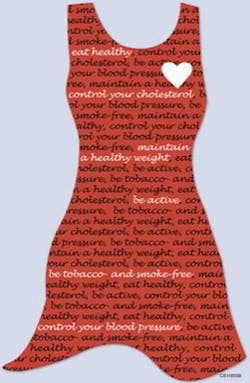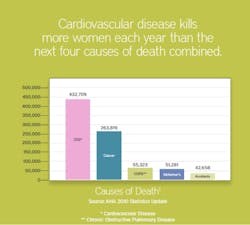Heart disease affects women and men differently
By Maria Perno Goldie, RDH, MS
Heart disease affects and manifests itself differently in women and men. Coronary heart disease (CHD), which includes myocardial infarction (MI; heart attack) and angina pectoris (AP), stroke, congestive heart failure (CHF), and cardiac arrest are types of cardiovascular disease (CVD). CVD affects 25% of American women and men, and is the leading killer in America.(1) However, it is often viewed as a “man’s disease.”(2) Since 1984, more women than men have died of CVD every year.(3) In 2002, CVD killed 493,623 women compared with 433,825 men. Fifty-three percent of CVD deaths occur in women.(3)Women characteristically develop clinically evident CHD up to 10 years later than men. (1) According to the Framingham Heart Study (FHS), the lifetime risk of developing CHD after age 40 is 49% and 32% in men and women, respectively.(1) While CHD deaths have decreased in men, studies indicate that CHD deaths in women have remained stable or even have increased.(4) After menopause, the rate of CHD is 2-3 times that of premenopausal women who are the same age.(3) Cardiac arrest is about three times greater in men than in women, However, women have lower recovery and survival rates than men.(5) Studies have shown that low levels of HDL convey a higher risk for CVD in women.(3,6) Women’s total cholesterol is higher than men’s cholesterol beginning at age 45.(3) As women go through menopause, their lipid profiles change and become more atherogenic.(4) High triglycerides may increase the risk of CVD for women more than for men.(7)
Heart disease affects and manifests itself differently in women and men. Coronary heart disease (CHD), which includes myocardial infarction (MI; heart attack) and angina pectoris (AP), stroke, congestive heart failure (CHF), and cardiac arrest are types of cardiovascular disease (CVD). CVD affects 25% of American women and men, and is the leading killer in America.(1) However, it is often viewed as a “man’s disease.”(2) Since 1984, more women than men have died of CVD every year.(3) In 2002, CVD killed 493,623 women compared with 433,825 men. Fifty-three percent of CVD deaths occur in women.(3)Women characteristically develop clinically evident CHD up to 10 years later than men. (1) According to the Framingham Heart Study (FHS), the lifetime risk of developing CHD after age 40 is 49% and 32% in men and women, respectively.(1) While CHD deaths have decreased in men, studies indicate that CHD deaths in women have remained stable or even have increased.(4) After menopause, the rate of CHD is 2-3 times that of premenopausal women who are the same age.(3) Cardiac arrest is about three times greater in men than in women, However, women have lower recovery and survival rates than men.(5) Studies have shown that low levels of HDL convey a higher risk for CVD in women.(3,6) Women’s total cholesterol is higher than men’s cholesterol beginning at age 45.(3) As women go through menopause, their lipid profiles change and become more atherogenic.(4) High triglycerides may increase the risk of CVD for women more than for men.(7)
There is a Go Red Heart CheckUp. Take the Go Red Heart CheckUp today to learn your risk. It’s free, only takes a few minutes and could save your life.(8) Evidence-Based Guidelines for the Prevention of Cardiovascular Disease in Women are available.(9) They include Lifestyle Interventions, Major Risk Factor Interventions, Preventive Drug Interventions, and an Explanation of Recommendation Classifications.
Understand your risks! Your heart is in your hands. Heart disease and stroke are largely preventable if you work to lower your risks. It's important to know that there are a range of factors that can raise your risk of heart disease and stroke. The more risk factors you have, the greater your chances of developing heart disease and having a heart attack or stroke.(10)
National Wear Red Day is a day when Americans nationwide will wear red to show their support for women's heart disease awareness. This observance promotes the Red Dress symbol and provides an opportunity for everyone to unite in this life-saving awareness movement by showing off a favorite red dress, shirt, or tie, or Red Dress Pin. Participate in National Wear Red Day. Everyone (men too) can support the fight against heart disease in women by wearing red on February 3, 2012. See CDC's Office of Women's Health, Wear It Well: Women and Heart Disease Prevention.(11)
WomenHeart: The National Coalition for Women with Heart Disease is the nation’s only patient-centered organization serving the 42 million American women living with or at risk for heart disease, the leading cause of death for women.(12) WomenHeart is solely devoted to advancing women’s heart health through advocacy, community education, and the nation’s only patient support network for women living with heart disease. WomenHeart is both a coalition and a community of thousands of members nationwide, including women heart patients and their families, healthcare professionals, and health advocates, all committed to helping women live longer, healthier lives.The 2011 10 Q Report presents a consensus by leading experts on the Top 10 questions in cardiovascular care for women.(13) The report provides a road map for future research concerning women’s cardiovascular health. Answers to the 10 questions should improve early detection, accurate diagnosis and treatment for women living with or at risk of heart disease.
Matters of the Heart: Second Annual Women's Heart Conference, presented by University of Minnesota Physicians Heart in cooperation with WomenHeart: The National Coalition for Women with Heart Disease and the American Heart Association, will be held February 17, 2012, The Westin Hotel Galleria, Edina, MN, for healthcare professionals.(14)References
1. Heart disease and stroke statistics-2005 Update. 2004. Dallas, TX American Heart Association www.americanheart.org. 2. Women, heart disease and stroke. American Heart Association www.americanheart.org.3. Women and cardiovascular diseases-Statistics. 2004 American Heart Association www.americanheart.org. 4. Mieres, J.H., et al., Role of noninvasive testing in the clinical evaluation of women with suspected coronary artery disease: consensus statement from the Cardiac Imaging Committee, Council on Clinical Cardiology, and the Cardiovascular Imaging and Intervention Committee, Council on Cardiovascular Radiology and Intervention, American Heart Association. Circulation, 2005. 111(5): p. 682-96. 5. Kim, C., et al., Out-of-hospital cardiac arrest in men and women. Circulation, 2001, 104 (22): p. 2699-703.6. Polk, D.M. and T.Z. Naqvi, Cardiovascular disease in women: sex differences in presentation, risk factors, and evaluation. Curr Cardiol Rep, 2005. 7(3): p. 166-72.7. The Health Consequences of Smoking: A Report of the Surgeon General. 2004. Department of Health and Human Services.8. www.goredforwomen.org/hcu/index.aspx. 9. www.goredforwomen.org/Professionals/.10. www.goredforwomen.org/understand_your_risks.aspx.11. www.cdc.gov/women/heart/.12. www.womenheart.org/. 13. www.womenheart.org/documents/upload/10Q-FINAL-REVISED-6-28-11.pdf. 14. www.umphysicians.org/womensheartconf/.
1. Heart disease and stroke statistics-2005 Update. 2004. Dallas, TX American Heart Association www.americanheart.org. 2. Women, heart disease and stroke. American Heart Association www.americanheart.org.3. Women and cardiovascular diseases-Statistics. 2004 American Heart Association www.americanheart.org. 4. Mieres, J.H., et al., Role of noninvasive testing in the clinical evaluation of women with suspected coronary artery disease: consensus statement from the Cardiac Imaging Committee, Council on Clinical Cardiology, and the Cardiovascular Imaging and Intervention Committee, Council on Cardiovascular Radiology and Intervention, American Heart Association. Circulation, 2005. 111(5): p. 682-96. 5. Kim, C., et al., Out-of-hospital cardiac arrest in men and women. Circulation, 2001, 104 (22): p. 2699-703.6. Polk, D.M. and T.Z. Naqvi, Cardiovascular disease in women: sex differences in presentation, risk factors, and evaluation. Curr Cardiol Rep, 2005. 7(3): p. 166-72.7. The Health Consequences of Smoking: A Report of the Surgeon General. 2004. Department of Health and Human Services.8. www.goredforwomen.org/hcu/index.aspx. 9. www.goredforwomen.org/Professionals/.10. www.goredforwomen.org/understand_your_risks.aspx.11. www.cdc.gov/women/heart/.12. www.womenheart.org/. 13. www.womenheart.org/documents/upload/10Q-FINAL-REVISED-6-28-11.pdf. 14. www.umphysicians.org/womensheartconf/.
Maria Perno Goldie, RDH, MS
To read previous articles in RDH eVillage FOCUS written by Maria Perno Goldie, go to articles.






